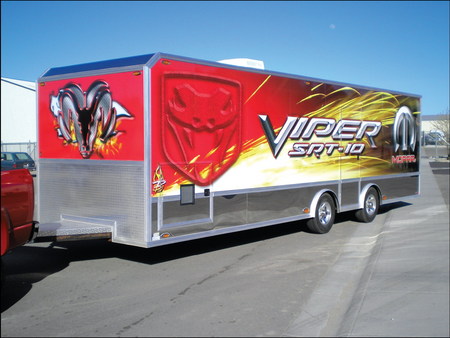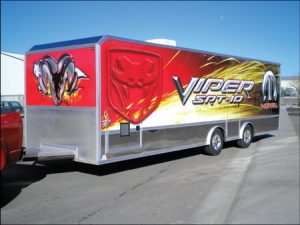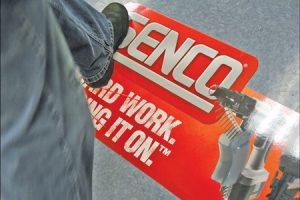Most wide-format graphics veterans accept that overlaminates are necessary for a wide-format graphic. However, I’m still regularly asked, “Do I need to laminate my graphic?” I generally answer with a question of my own: “How are the graphics going to be used?” If the customer requires durability beyond two to three years, a laminate will be needed. If the graphic will be applied in a high-traffic area, a laminate will protect the image from damage.
Why laminate?
Some may wonder, “What is an overlaminate?” Sometimes an overlaminate is interchangeably referred to as a laminate or film laminate.
A film laminate is basically a clear film with adhesive (pressure-sensitive or heat-activated, we will focus on pressure-sensitive) that is applied to a printed graphic for at least one of the following reasons:
Increased durability. Solvent inks, including mild and eco-solvent, generally last two to three years outdoors without protection. Laminates contain UV inhibitors that help protect the inks from the sun’s UV rays and slow the fading process. Solvent digital graphics can offer five-year durability, depending on the inks, printing material and laminate used.
Abrasion resistance. Overlaminates protect the inks from abrasion and perpetuate image quality longer. Always use laminates on vehicle applications because they protect against a car wash’s abrasive bristles. Laminate long-term wall graphics in high-traffic areas, where people might brush up against the image, or if they require frequent cleaning. Out-of-reach graphics, however, can be left unlaminated as long as the durability requirements don’t exceed the unprotected ink’s durability.
Advertisement
Finish. What if an intermediate calendered film with a matte finish may be used, but the customer requires a gloss finish? A glossy laminate can change the finished graphic’s gloss level. The opposite can be accomplished by printing on a very glossy material and applying a matte laminate.
Ease of handling. An overlaminate can also help reduce the need for a premask (aka an application tape) when installing some graphics. Premasks aren’t as conformable as vehicle graphics. Installers who encounter a complex curve while premasking must stop and peel away the premask so the film can conform to the surface. The increased thickness also helps applications such as wall graphics.
Exceptions include large fleet graphics and high-temperature applications. Premasking helps installers avoid stretching the large panels of film during fleet applications. Also, film can stretch in high temperature climates, but a premask can add rigidity and minimize stretching.
The two most common films for wide-format graphics are cast and calendered. Generaly, cast films are considered the premium films for longer-term applications (up to five years) and/or applications that require conformability to complex, compound and concave curves (such as vehicle wraps or fleet applications). Calendered films are generally for medium to short-term (one to three years) applications that don’t require conformability.
Technology and trends
Recently, several media manufacturers introduced thinner versions of their premium, cast-vinyl overlaminates. By reducing a finished graphic’s thickness, these thinner versions will ultimately aid the film’s conformability. The thickness of these films range from 1 mil to 1.5 mil, depending on the manufacturer.
Advertisement
Some laminated, UV, digital prints exhibited a problem known as “silvering,” where tiny air bubbles are trapped between the film and the laminate. UV inks lie atop the film and don’t sink in like solvent inks, which creates hills and valleys. Sometimes the laminate’s adhesive sticks only to the high points, leaving small air gaps or bubbles.
Specialty laminates also offer unique features, such as texture, to printed graphics. Others can contain metal flakes that create a metalized look when applied over a printed graphic.
Special looks are also being created with time-honored laminates. Back in the days of the Ford Mustang, Chevrolet Camaro and Dodge Challenger, car hoods were often painted a matte black. Now, with the “Big Three” auto manufacturers again designing vehicles based on the old muscle cars, it’s no surprise to see matte laminates being used to create these retro looks.
Equipment
Remember, a film laminator is required to apply overlaminates; many shops overlook this when considering the jump into wide-format digital graphics. With several different laminators available, considerations prevail: Does the laminator laminate the same width as your printed material? Can it support a 50-yd. media roll? If you run a higher-production shop, you may even want to use 100-yd. rolls. The laminator should have a take-up roll to collect the liner as it’s removed from the laminate.
Never hesitate to contact your media supplier for its help and opinion. Speaking from experience, I would much rather prevent a negative experience and help a customer make the right decision ahead of time, than troubleshoot afterwards.
Advertisement


 Tip Sheet4 days ago
Tip Sheet4 days ago
 Business Management2 weeks ago
Business Management2 weeks ago
 Women in Signs2 weeks ago
Women in Signs2 weeks ago
 Real Deal5 days ago
Real Deal5 days ago
 Benchmarks17 hours ago
Benchmarks17 hours ago
 Editor's Note1 week ago
Editor's Note1 week ago
 Line Time2 weeks ago
Line Time2 weeks ago
 Product Buying + Technology1 week ago
Product Buying + Technology1 week ago



















